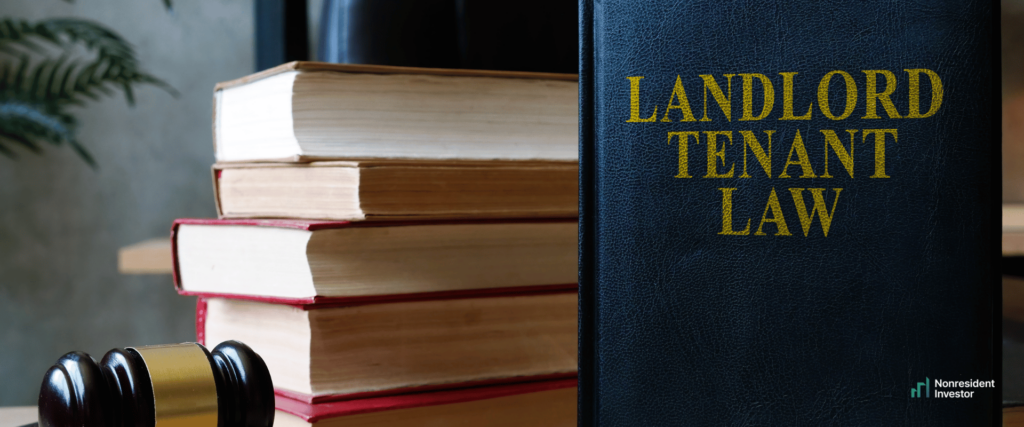If you’ve ever considered generating passive income through US real estate investing without signing a contract with your tenant, think again. Just like you can’t build a house without a solid foundation, you cannot pursue a cash flow investment strategy without insurance. And in the case of real estate investing, the insurance is your rental and lease agreement.
Having a foolproof rental and lease agreement with a tenant legally protects investors and their properties from potentially problematic tenants. This contact also puts everything in black and white, leaving no room for misunderstandings.
Optimizing risk management like this is particularly important to nonresident investors. If you’re investing in US real estate from across the ocean, you won’t be able to monitor your properties as closely. That is where the legal protection that a contract provides comes particularly in handy.
But what is a rental and lease agreement, and what does it define? How do you even draft one? We’ll answer all of these and more questions in this article.
What Is a Rental and Lease Agreement?
A rental and lease agreement is a legal document that a landlord and a tenant sign that defines the conditions under which the tenant can use the landlord’s property. That entails everything from the duration of the tenant’s stay to their obligations (as well as rights) while living there.
If the tenant were to break any of the points defined by this document, the landlord would be eligible to receive appropriate damages or pursue legal action against the tenant.

Who Owns the Landlord-Tenant Contract?
You (the investor) should always be the owner of the landlord-tenant contract. However, if you are employing a property manager or agency, they will sometimes try to form a contract with their name on it — you should never let them do that. If you do, it may cause you unnecessary issues in the long run.
For instance, if you aren’t the owner of the contract and you part ways with your property manager or agency, you will need to renew the contract with your tenant immediately. If your name were on the contract from the get-go, the document would still be valid, and you’d avoid any unnecessary hassle.
How Long Should a Rental and Lease Agreement Last?
A rental and lease agreement usually lasts at least one year, but it can be shorter or longer (based on individual preferences). Most investors opt for at least one-year contracts because it makes it easier for them to track the ROI of their investment. It also allows them to occasionally make changes to the agreement (if necessary) without annexing the contract.
So if you want to invest in US real estate over the long haul, we suggest you form at least two-year contracts. The reason is that most property managers or agencies come with a fee for handling tenant contracts — a fee you’ll need to pay every time you renew a contract. So the more time there is between contract renewals, the less money you’ll spend on these fees.
How Detailed Should a Rental and Lease Agreement Be?
Thirty years ago, rental and lease agreement was just a few pages long. However, the need for additional regulation grew over time. Nowadays, they can even go above 20 pages.
Still, it’s impossible to objectively determine how detailed an agreement should be — it will mostly depend on how stringently you want to define your and your tenant’s relationship.
We advise making the agreement as detailed as possible since you intend to run a business. And one of the key factors of each successful business is risk management — the fewer uncertainties you have, the better it will be for your bottom line.

What Should a Contract With a Tenant Contain?
As we mentioned above, what your contract with your tenant contains will largely depend on how well you want to protect yourself. However, we realize you are, like most foreigners, probably unfamiliar with US laws and legal practices. That’s why we’ll cover the most important sections of typical rental and lease agreements and illustrate what each of them regulates. That way, you can get a good picture of how your contract should look, even without any legal knowledge.
1. Residency and Financials
This introductory clause covers the basic terms of the rental and lease agreement, which includes the following:
- A short, basic document overview;
- Personal information about the signing parties;
- Defines the property address and rental terms (i.e., the duration of the agreement);
- Determines the size of the rent;
- Clarifies who is responsible for covering the costs of utilities;
- Designates the size of the security deposit;
- Defines special conditions (if there are any).
Overall, this introductory section defines the contract’s key details and the tenants’ core obligations.
2. Policies and Procedures
This section is a pretty detailed one and regulates a variety of things, like the following:
- The conditions under which the landlord is allowed to enter the property;
- The terms that the tenant needs to abide by if they leave the property early;
- The various rules of conduct tenants are required to follow while living on the property;
- The tenants’ rights in unfortunate cases of property damage that render it untenantable;
- A few provisions related to the notice of domestic abuse protections, smoke detector notices, criminal activity, use of the premises and guests, and similar.
Overall, this section regulates the relationship between the tenant and the landlord, including their rights and obligations.
3. General Clauses
This section just requires the tenant to acknowledge they have been informed about all the contents of the contract. It also discloses that the landlord has full rights to provide occasional addendums to the agreement if necessary.
4. Disclosure of Information on Lead-Based Paint and/or Lead-Based Paint Hazards (Case-Specific)
This clause is only added to agreements for an older home (built before 1978). The reason is that those kinds of homes may contain traces of lead-based paint, so this clause protects the investor from liability in rare cases when traces of lead-based paint remain in the household (since they may cause lead poisoning).
5. Nonstandard Rental Provisions
This contract section protects the investor’s interests by clearly defining the conditions surrounding the move-ins and move-outs, as well as all unexpected expenses and their costs. These include but are not limited to the following:
- Notice to Move — Requires tenants to provide a 30-day notice before moving out;
- Winter Move-Out Clause — Prohibits the tenants from moving out during winter months;
- Early Termination — Defines the conditions under which tenants can terminate their contract early;
- Late Rent Fee — Defines the interest the landlord is entitled to if the tenant is late on paying rent;
- Lock-Out Fee — If the tenant, for any reason, finds themselves locked out of the property, they will need to cover this fee;
- New Key Fee — Defines how much replacing a key would cost;
- Lock Change Fee — Determines how much replacing a lock would cost if the need arises;
- Garbage/Trash Removal Fee — This fee is deducted from the tenant’s security deposit if they fail to handle trash removal regularly.
6. Rules and Regulations Handbook
This in-depth clause goes through various sections defining the relationship and obligations of both the tenant and the landlord. Here are some of the things this section regulates:
- Residential responsibilities;
- Security deposit;
- Rent payment conditions;
- Home check-in and check-out times;
- Right of entry;
- Mail;
- Utilities, phone, and cable;
- Drains and toilets;
- Parking;
- Trash and recycling;
- Eviction procedures.
The most important part of this section is undoubtedly the one that covers the eviction terms and procedure. That gives the tenant a clear idea of what actions may lead to an eviction and also allows the investor to streamline the process if the worst comes to worst.
7. Winter Clause
The Winter Clause is a short section that investors usually add to a contract to prevent tenants from moving out during winter months (November, December, January, and February). The reason is that finding new tenants is significantly harder during winter, which would result in the loss of valuable rent and would reflect poorly on their ROI.
8. Pet Clause
This clause regulates whether the property is pet-friendly. If it is, the section also contains the rules and regulations related to keeping a pet on the premises, including the fee for each pet. This clause also specifies if certain animal breeds are prohibited from being kept on the property (e.g., large or dangerous dog breeds).

Are Rental and Lease Agreements the Same in All States?
Although many of the clauses in rental and lease agreements are identical from state to state, not all are. Different US states have different local real estate laws, which may change specific clauses or add new ones, depending on where you buy your property.
Here are just some of the most common variables that differ from state to state:
- How soon the landlord is allowed to launch the eviction process against a tenant who is skipping rent payments;
- The size and maximum limit of the security deposit;
- The maximum amount of rent allowed for a property of a particular size;
- And much more…
The most important variable for investors is the one that regulates the eviction process of problematic tenants. The most landlord-friendly states allow you to evict a tenant after skipping three months of rent, while for some, that number goes up to a year. If you have a property in a non-landlord-friendly state and your tenant refuses to pay rent regularly, you will lose significantly more of your ROI until you can evict them.
Due to all of these local differences between contracts, you should always consult with a legal counselor familiar with local real estate laws before drafting the final version of the agreement.
3 Things to Keep in Mind Before You Sign Your First Rental and Lease Agreement with a Tenant
Before we wrap up, we wanted to share three tips from our CEO, Luka Malkovich, based on his years of experience in US real estate investing. We’re sure you’ll find them invaluable.

1. Make Sure Your Tenant Signs Every Single Page of the Lease Agreement
Although this may seem like a chore, it ensures they acknowledge that they have read the entire agreement. That eliminates any potential foul play down the line. This measure is pretty standard in the industry, and all experienced lawyers and agents practice it, so you should do the same.
2. Always Background Check Your Tenant
Even though a solid contract can protect you from bad tenants, it will only mitigate some of the damage. That’s why knowing how to choose the right tenant is the single most important part of being a nonresident investor. That’s why you should always do a detailed background check on your tenant before you sign them on. It will pay off in the long run.
3. Always Consult a Lawyer Familiar With Local Real Estate Laws
No matter how well you do your homework, nothing beats having a professional look at and review your contract. That is the only way to be 100% sure it’s foolproof. Yes, hiring a lawyer to help you handle the process will cost you, but the amount you could lose if you make any errors in the contract is much greater.

